Construction Procurement and Processes Scenario Report - London Bank
VerifiedAdded on 2022/12/30
|11
|3424
|51
Report
AI Summary
This report provides a comprehensive analysis of construction procurement and processes, focusing on a scenario involving the construction of a new head office for a bank in London. The report begins by defining the characteristics of the selected project type, which is commercial building construction, and assessing the client's risk attitude. It then delves into a comparison and evaluation of different procurement methods, including general contracting, design-build, construction management, and private finance initiatives, ultimately justifying the selection of construction management for the project. Furthermore, the report evaluates competitive and negotiated approaches in contractor selection, explores the role and comparison between different types of subcontractors, and concludes with a summary of the key findings and recommendations. The report addresses economic considerations, project characteristics, and the client's objectives of sustainability and value for money, making it a practical guide for construction procurement decision-making.
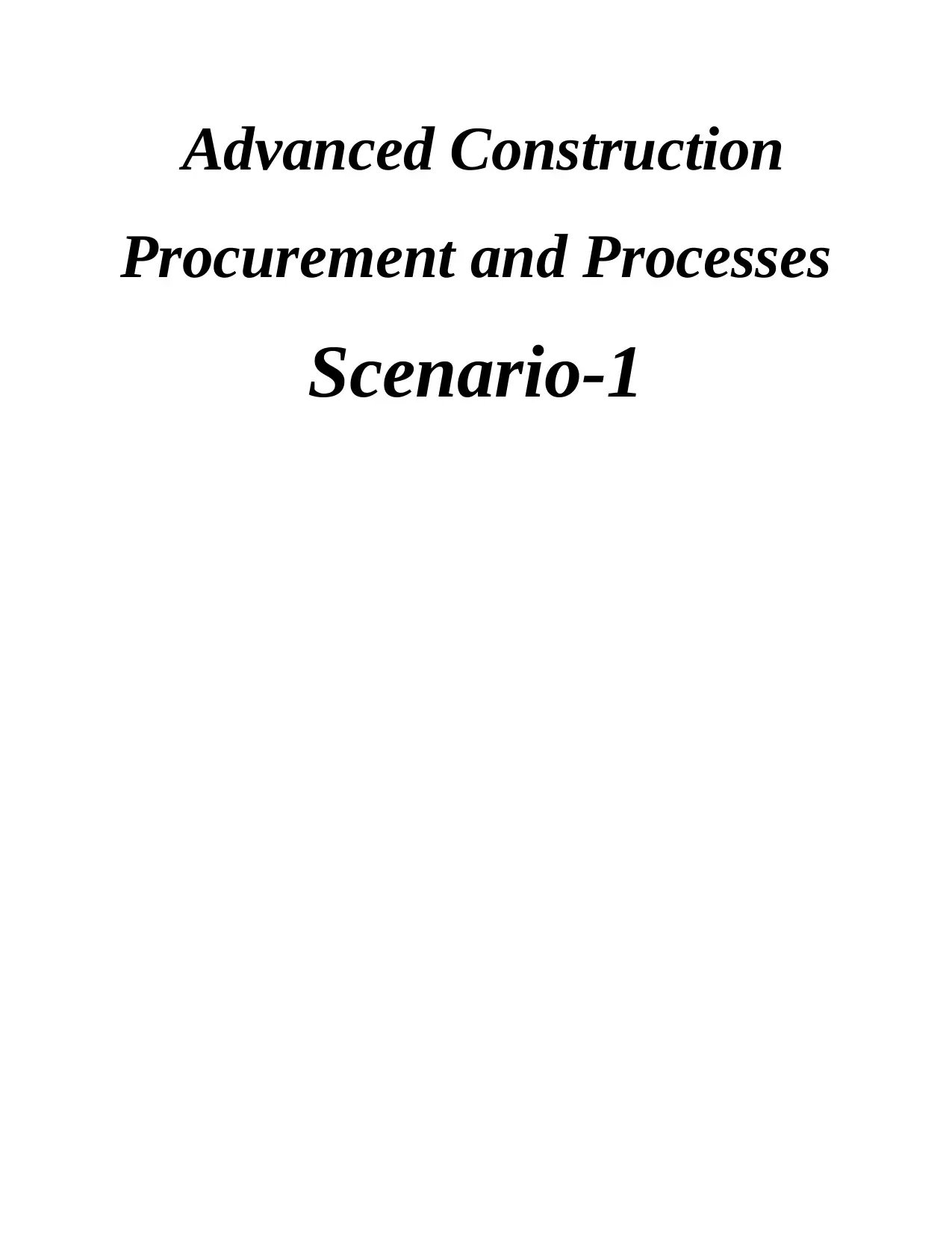
Advanced Construction
Procurement and Processes
Scenario-1
Procurement and Processes
Scenario-1
Paraphrase This Document
Need a fresh take? Get an instant paraphrase of this document with our AI Paraphraser
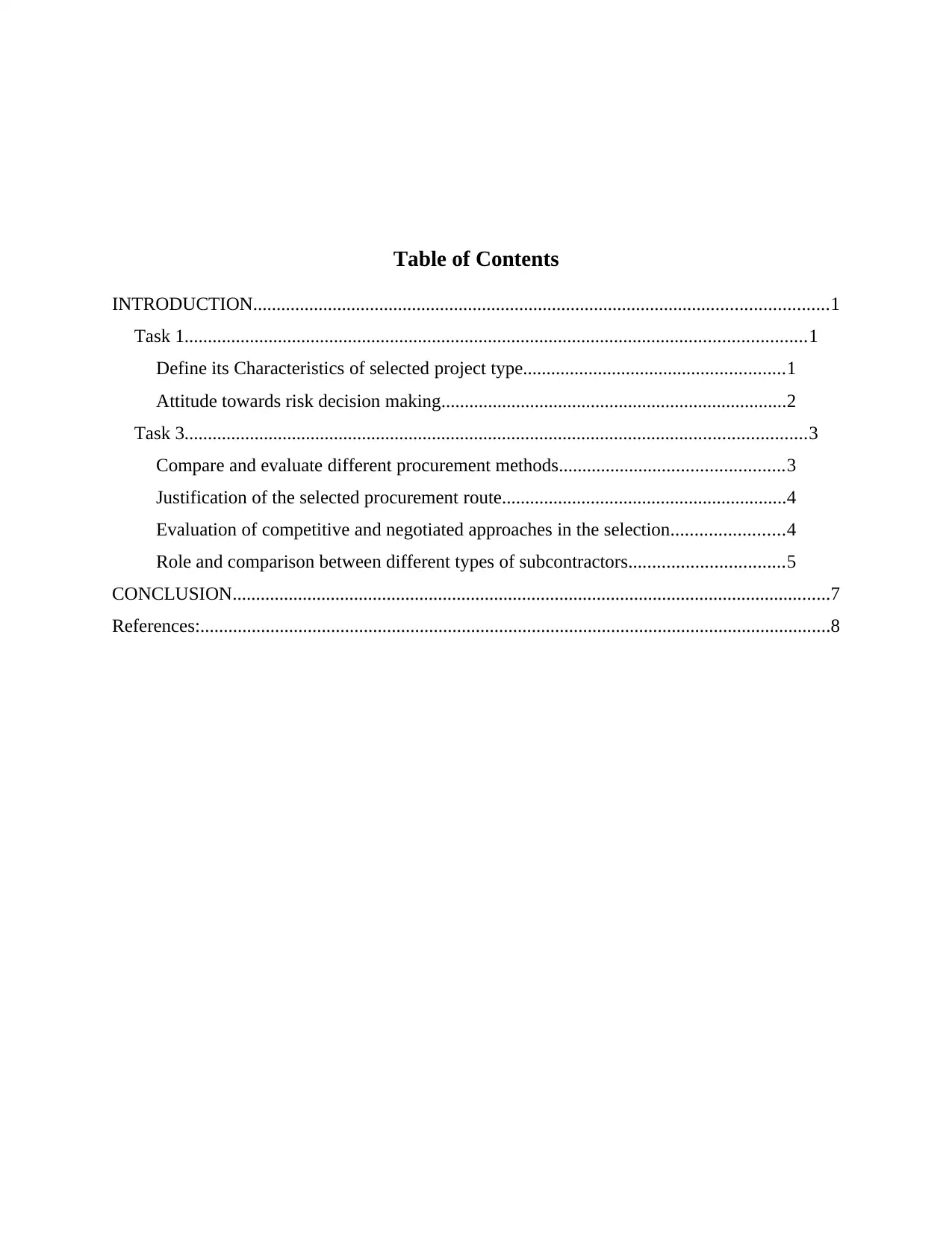
Table of Contents
INTRODUCTION...........................................................................................................................1
Task 1.....................................................................................................................................1
Define its Characteristics of selected project type........................................................1
Attitude towards risk decision making..........................................................................2
Task 3.....................................................................................................................................3
Compare and evaluate different procurement methods................................................3
Justification of the selected procurement route.............................................................4
Evaluation of competitive and negotiated approaches in the selection........................4
Role and comparison between different types of subcontractors.................................5
CONCLUSION................................................................................................................................7
References:.......................................................................................................................................8
INTRODUCTION...........................................................................................................................1
Task 1.....................................................................................................................................1
Define its Characteristics of selected project type........................................................1
Attitude towards risk decision making..........................................................................2
Task 3.....................................................................................................................................3
Compare and evaluate different procurement methods................................................3
Justification of the selected procurement route.............................................................4
Evaluation of competitive and negotiated approaches in the selection........................4
Role and comparison between different types of subcontractors.................................5
CONCLUSION................................................................................................................................7
References:.......................................................................................................................................8
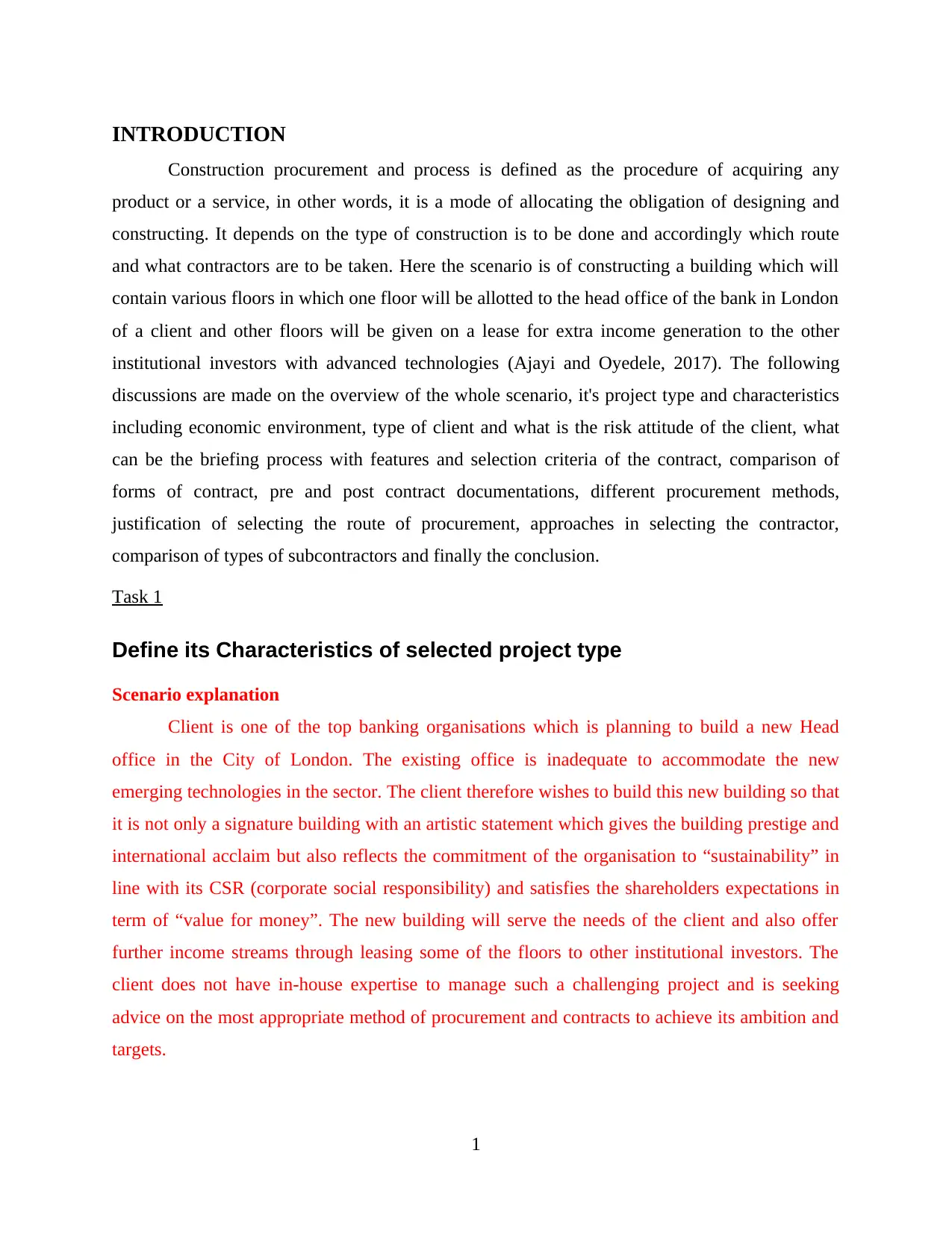
INTRODUCTION
Construction procurement and process is defined as the procedure of acquiring any
product or a service, in other words, it is a mode of allocating the obligation of designing and
constructing. It depends on the type of construction is to be done and accordingly which route
and what contractors are to be taken. Here the scenario is of constructing a building which will
contain various floors in which one floor will be allotted to the head office of the bank in London
of a client and other floors will be given on a lease for extra income generation to the other
institutional investors with advanced technologies (Ajayi and Oyedele, 2017). The following
discussions are made on the overview of the whole scenario, it's project type and characteristics
including economic environment, type of client and what is the risk attitude of the client, what
can be the briefing process with features and selection criteria of the contract, comparison of
forms of contract, pre and post contract documentations, different procurement methods,
justification of selecting the route of procurement, approaches in selecting the contractor,
comparison of types of subcontractors and finally the conclusion.
Task 1
Define its Characteristics of selected project type
Scenario explanation
Client is one of the top banking organisations which is planning to build a new Head
office in the City of London. The existing office is inadequate to accommodate the new
emerging technologies in the sector. The client therefore wishes to build this new building so that
it is not only a signature building with an artistic statement which gives the building prestige and
international acclaim but also reflects the commitment of the organisation to “sustainability” in
line with its CSR (corporate social responsibility) and satisfies the shareholders expectations in
term of “value for money”. The new building will serve the needs of the client and also offer
further income streams through leasing some of the floors to other institutional investors. The
client does not have in-house expertise to manage such a challenging project and is seeking
advice on the most appropriate method of procurement and contracts to achieve its ambition and
targets.
1
Construction procurement and process is defined as the procedure of acquiring any
product or a service, in other words, it is a mode of allocating the obligation of designing and
constructing. It depends on the type of construction is to be done and accordingly which route
and what contractors are to be taken. Here the scenario is of constructing a building which will
contain various floors in which one floor will be allotted to the head office of the bank in London
of a client and other floors will be given on a lease for extra income generation to the other
institutional investors with advanced technologies (Ajayi and Oyedele, 2017). The following
discussions are made on the overview of the whole scenario, it's project type and characteristics
including economic environment, type of client and what is the risk attitude of the client, what
can be the briefing process with features and selection criteria of the contract, comparison of
forms of contract, pre and post contract documentations, different procurement methods,
justification of selecting the route of procurement, approaches in selecting the contractor,
comparison of types of subcontractors and finally the conclusion.
Task 1
Define its Characteristics of selected project type
Scenario explanation
Client is one of the top banking organisations which is planning to build a new Head
office in the City of London. The existing office is inadequate to accommodate the new
emerging technologies in the sector. The client therefore wishes to build this new building so that
it is not only a signature building with an artistic statement which gives the building prestige and
international acclaim but also reflects the commitment of the organisation to “sustainability” in
line with its CSR (corporate social responsibility) and satisfies the shareholders expectations in
term of “value for money”. The new building will serve the needs of the client and also offer
further income streams through leasing some of the floors to other institutional investors. The
client does not have in-house expertise to manage such a challenging project and is seeking
advice on the most appropriate method of procurement and contracts to achieve its ambition and
targets.
1
⊘ This is a preview!⊘
Do you want full access?
Subscribe today to unlock all pages.

Trusted by 1+ million students worldwide
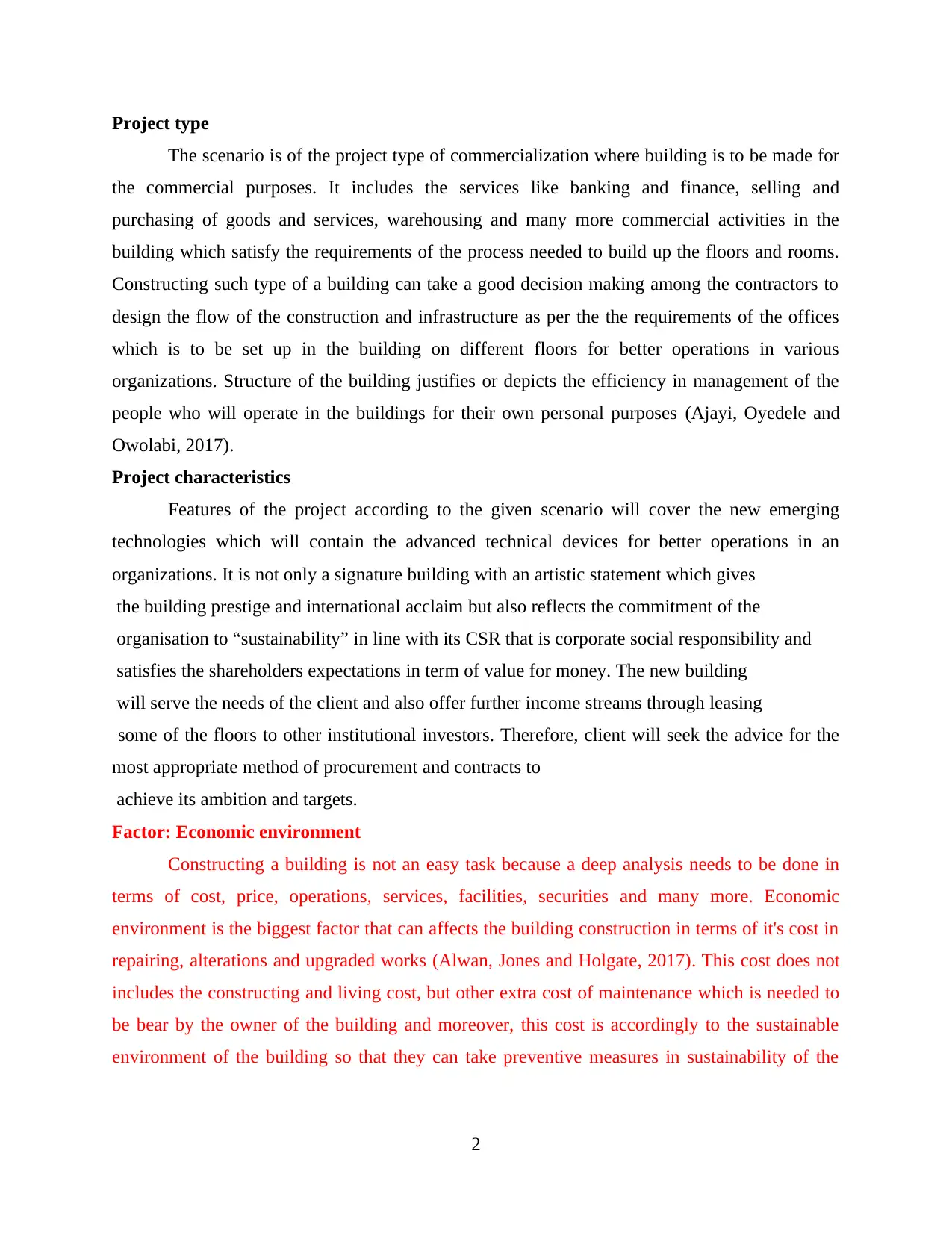
Project type
The scenario is of the project type of commercialization where building is to be made for
the commercial purposes. It includes the services like banking and finance, selling and
purchasing of goods and services, warehousing and many more commercial activities in the
building which satisfy the requirements of the process needed to build up the floors and rooms.
Constructing such type of a building can take a good decision making among the contractors to
design the flow of the construction and infrastructure as per the the requirements of the offices
which is to be set up in the building on different floors for better operations in various
organizations. Structure of the building justifies or depicts the efficiency in management of the
people who will operate in the buildings for their own personal purposes (Ajayi, Oyedele and
Owolabi, 2017).
Project characteristics
Features of the project according to the given scenario will cover the new emerging
technologies which will contain the advanced technical devices for better operations in an
organizations. It is not only a signature building with an artistic statement which gives
the building prestige and international acclaim but also reflects the commitment of the
organisation to “sustainability” in line with its CSR that is corporate social responsibility and
satisfies the shareholders expectations in term of value for money. The new building
will serve the needs of the client and also offer further income streams through leasing
some of the floors to other institutional investors. Therefore, client will seek the advice for the
most appropriate method of procurement and contracts to
achieve its ambition and targets.
Factor: Economic environment
Constructing a building is not an easy task because a deep analysis needs to be done in
terms of cost, price, operations, services, facilities, securities and many more. Economic
environment is the biggest factor that can affects the building construction in terms of it's cost in
repairing, alterations and upgraded works (Alwan, Jones and Holgate, 2017). This cost does not
includes the constructing and living cost, but other extra cost of maintenance which is needed to
be bear by the owner of the building and moreover, this cost is accordingly to the sustainable
environment of the building so that they can take preventive measures in sustainability of the
2
The scenario is of the project type of commercialization where building is to be made for
the commercial purposes. It includes the services like banking and finance, selling and
purchasing of goods and services, warehousing and many more commercial activities in the
building which satisfy the requirements of the process needed to build up the floors and rooms.
Constructing such type of a building can take a good decision making among the contractors to
design the flow of the construction and infrastructure as per the the requirements of the offices
which is to be set up in the building on different floors for better operations in various
organizations. Structure of the building justifies or depicts the efficiency in management of the
people who will operate in the buildings for their own personal purposes (Ajayi, Oyedele and
Owolabi, 2017).
Project characteristics
Features of the project according to the given scenario will cover the new emerging
technologies which will contain the advanced technical devices for better operations in an
organizations. It is not only a signature building with an artistic statement which gives
the building prestige and international acclaim but also reflects the commitment of the
organisation to “sustainability” in line with its CSR that is corporate social responsibility and
satisfies the shareholders expectations in term of value for money. The new building
will serve the needs of the client and also offer further income streams through leasing
some of the floors to other institutional investors. Therefore, client will seek the advice for the
most appropriate method of procurement and contracts to
achieve its ambition and targets.
Factor: Economic environment
Constructing a building is not an easy task because a deep analysis needs to be done in
terms of cost, price, operations, services, facilities, securities and many more. Economic
environment is the biggest factor that can affects the building construction in terms of it's cost in
repairing, alterations and upgraded works (Alwan, Jones and Holgate, 2017). This cost does not
includes the constructing and living cost, but other extra cost of maintenance which is needed to
be bear by the owner of the building and moreover, this cost is accordingly to the sustainable
environment of the building so that they can take preventive measures in sustainability of the
2
Paraphrase This Document
Need a fresh take? Get an instant paraphrase of this document with our AI Paraphraser
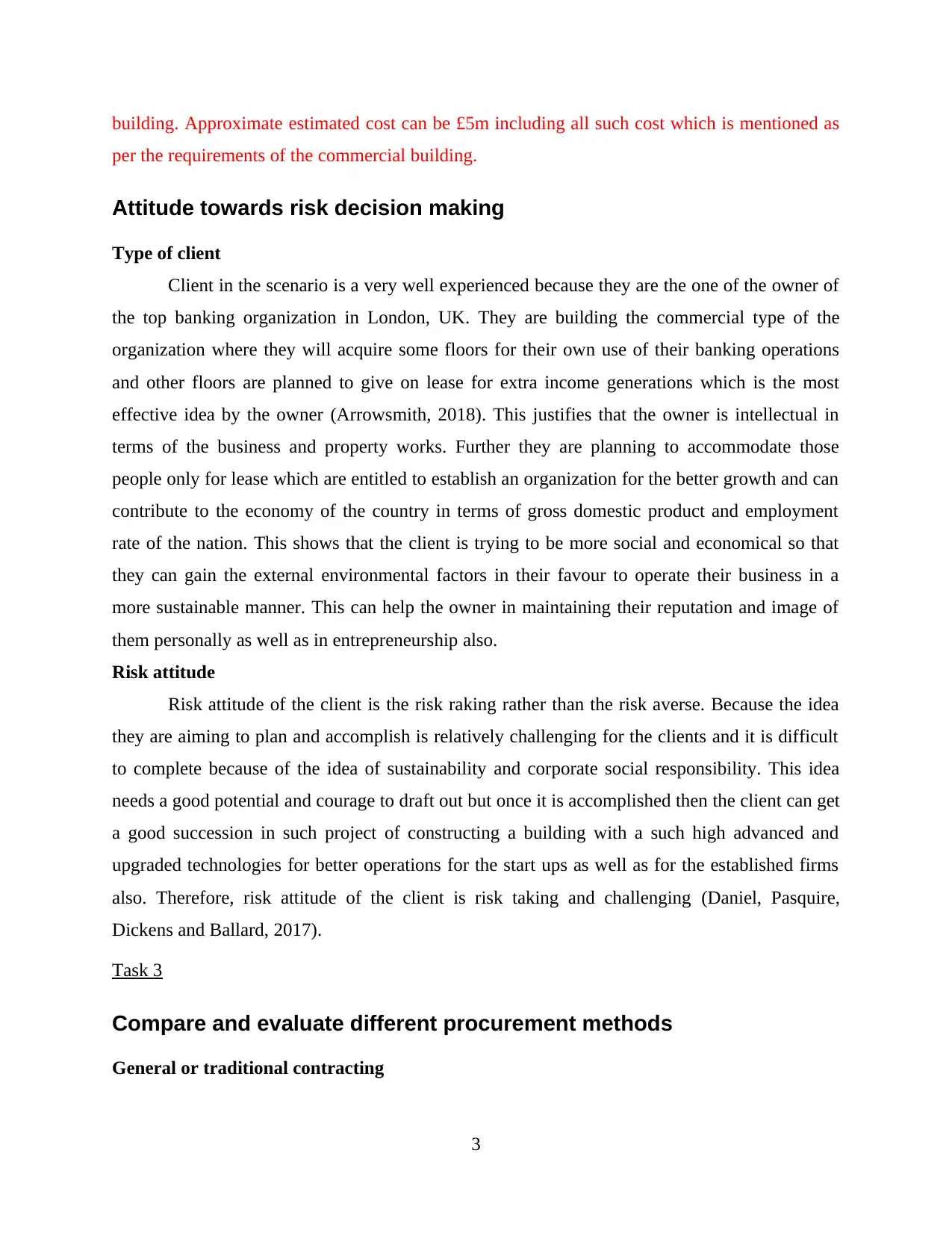
building. Approximate estimated cost can be £5m including all such cost which is mentioned as
per the requirements of the commercial building.
Attitude towards risk decision making
Type of client
Client in the scenario is a very well experienced because they are the one of the owner of
the top banking organization in London, UK. They are building the commercial type of the
organization where they will acquire some floors for their own use of their banking operations
and other floors are planned to give on lease for extra income generations which is the most
effective idea by the owner (Arrowsmith, 2018). This justifies that the owner is intellectual in
terms of the business and property works. Further they are planning to accommodate those
people only for lease which are entitled to establish an organization for the better growth and can
contribute to the economy of the country in terms of gross domestic product and employment
rate of the nation. This shows that the client is trying to be more social and economical so that
they can gain the external environmental factors in their favour to operate their business in a
more sustainable manner. This can help the owner in maintaining their reputation and image of
them personally as well as in entrepreneurship also.
Risk attitude
Risk attitude of the client is the risk raking rather than the risk averse. Because the idea
they are aiming to plan and accomplish is relatively challenging for the clients and it is difficult
to complete because of the idea of sustainability and corporate social responsibility. This idea
needs a good potential and courage to draft out but once it is accomplished then the client can get
a good succession in such project of constructing a building with a such high advanced and
upgraded technologies for better operations for the start ups as well as for the established firms
also. Therefore, risk attitude of the client is risk taking and challenging (Daniel, Pasquire,
Dickens and Ballard, 2017).
Task 3
Compare and evaluate different procurement methods
General or traditional contracting
3
per the requirements of the commercial building.
Attitude towards risk decision making
Type of client
Client in the scenario is a very well experienced because they are the one of the owner of
the top banking organization in London, UK. They are building the commercial type of the
organization where they will acquire some floors for their own use of their banking operations
and other floors are planned to give on lease for extra income generations which is the most
effective idea by the owner (Arrowsmith, 2018). This justifies that the owner is intellectual in
terms of the business and property works. Further they are planning to accommodate those
people only for lease which are entitled to establish an organization for the better growth and can
contribute to the economy of the country in terms of gross domestic product and employment
rate of the nation. This shows that the client is trying to be more social and economical so that
they can gain the external environmental factors in their favour to operate their business in a
more sustainable manner. This can help the owner in maintaining their reputation and image of
them personally as well as in entrepreneurship also.
Risk attitude
Risk attitude of the client is the risk raking rather than the risk averse. Because the idea
they are aiming to plan and accomplish is relatively challenging for the clients and it is difficult
to complete because of the idea of sustainability and corporate social responsibility. This idea
needs a good potential and courage to draft out but once it is accomplished then the client can get
a good succession in such project of constructing a building with a such high advanced and
upgraded technologies for better operations for the start ups as well as for the established firms
also. Therefore, risk attitude of the client is risk taking and challenging (Daniel, Pasquire,
Dickens and Ballard, 2017).
Task 3
Compare and evaluate different procurement methods
General or traditional contracting
3
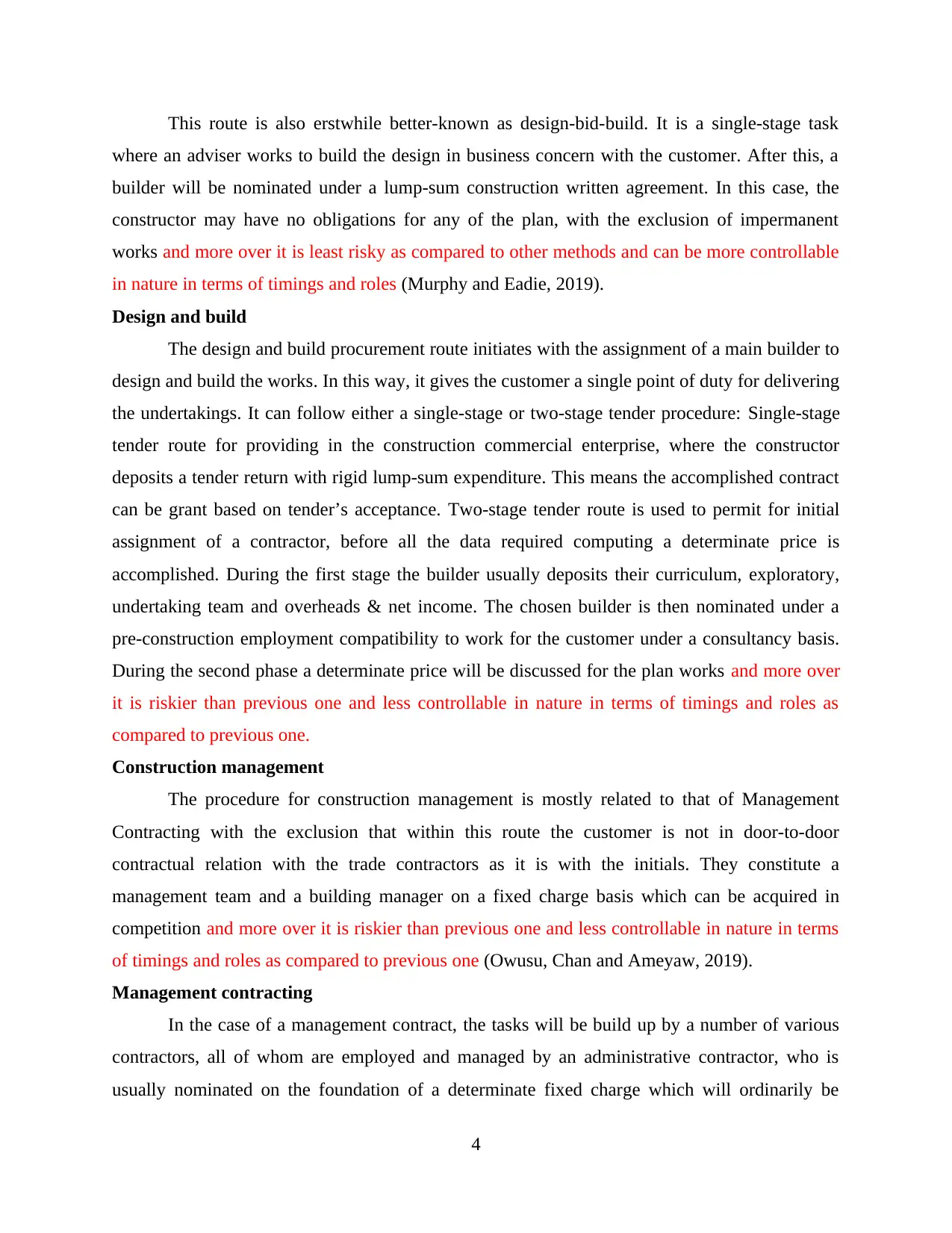
This route is also erstwhile better-known as design-bid-build. It is a single-stage task
where an adviser works to build the design in business concern with the customer. After this, a
builder will be nominated under a lump-sum construction written agreement. In this case, the
constructor may have no obligations for any of the plan, with the exclusion of impermanent
works and more over it is least risky as compared to other methods and can be more controllable
in nature in terms of timings and roles (Murphy and Eadie, 2019).
Design and build
The design and build procurement route initiates with the assignment of a main builder to
design and build the works. In this way, it gives the customer a single point of duty for delivering
the undertakings. It can follow either a single-stage or two-stage tender procedure: Single-stage
tender route for providing in the construction commercial enterprise, where the constructor
deposits a tender return with rigid lump-sum expenditure. This means the accomplished contract
can be grant based on tender’s acceptance. Two-stage tender route is used to permit for initial
assignment of a contractor, before all the data required computing a determinate price is
accomplished. During the first stage the builder usually deposits their curriculum, exploratory,
undertaking team and overheads & net income. The chosen builder is then nominated under a
pre-construction employment compatibility to work for the customer under a consultancy basis.
During the second phase a determinate price will be discussed for the plan works and more over
it is riskier than previous one and less controllable in nature in terms of timings and roles as
compared to previous one.
Construction management
The procedure for construction management is mostly related to that of Management
Contracting with the exclusion that within this route the customer is not in door-to-door
contractual relation with the trade contractors as it is with the initials. They constitute a
management team and a building manager on a fixed charge basis which can be acquired in
competition and more over it is riskier than previous one and less controllable in nature in terms
of timings and roles as compared to previous one (Owusu, Chan and Ameyaw, 2019).
Management contracting
In the case of a management contract, the tasks will be build up by a number of various
contractors, all of whom are employed and managed by an administrative contractor, who is
usually nominated on the foundation of a determinate fixed charge which will ordinarily be
4
where an adviser works to build the design in business concern with the customer. After this, a
builder will be nominated under a lump-sum construction written agreement. In this case, the
constructor may have no obligations for any of the plan, with the exclusion of impermanent
works and more over it is least risky as compared to other methods and can be more controllable
in nature in terms of timings and roles (Murphy and Eadie, 2019).
Design and build
The design and build procurement route initiates with the assignment of a main builder to
design and build the works. In this way, it gives the customer a single point of duty for delivering
the undertakings. It can follow either a single-stage or two-stage tender procedure: Single-stage
tender route for providing in the construction commercial enterprise, where the constructor
deposits a tender return with rigid lump-sum expenditure. This means the accomplished contract
can be grant based on tender’s acceptance. Two-stage tender route is used to permit for initial
assignment of a contractor, before all the data required computing a determinate price is
accomplished. During the first stage the builder usually deposits their curriculum, exploratory,
undertaking team and overheads & net income. The chosen builder is then nominated under a
pre-construction employment compatibility to work for the customer under a consultancy basis.
During the second phase a determinate price will be discussed for the plan works and more over
it is riskier than previous one and less controllable in nature in terms of timings and roles as
compared to previous one.
Construction management
The procedure for construction management is mostly related to that of Management
Contracting with the exclusion that within this route the customer is not in door-to-door
contractual relation with the trade contractors as it is with the initials. They constitute a
management team and a building manager on a fixed charge basis which can be acquired in
competition and more over it is riskier than previous one and less controllable in nature in terms
of timings and roles as compared to previous one (Owusu, Chan and Ameyaw, 2019).
Management contracting
In the case of a management contract, the tasks will be build up by a number of various
contractors, all of whom are employed and managed by an administrative contractor, who is
usually nominated on the foundation of a determinate fixed charge which will ordinarily be
4
⊘ This is a preview!⊘
Do you want full access?
Subscribe today to unlock all pages.

Trusted by 1+ million students worldwide
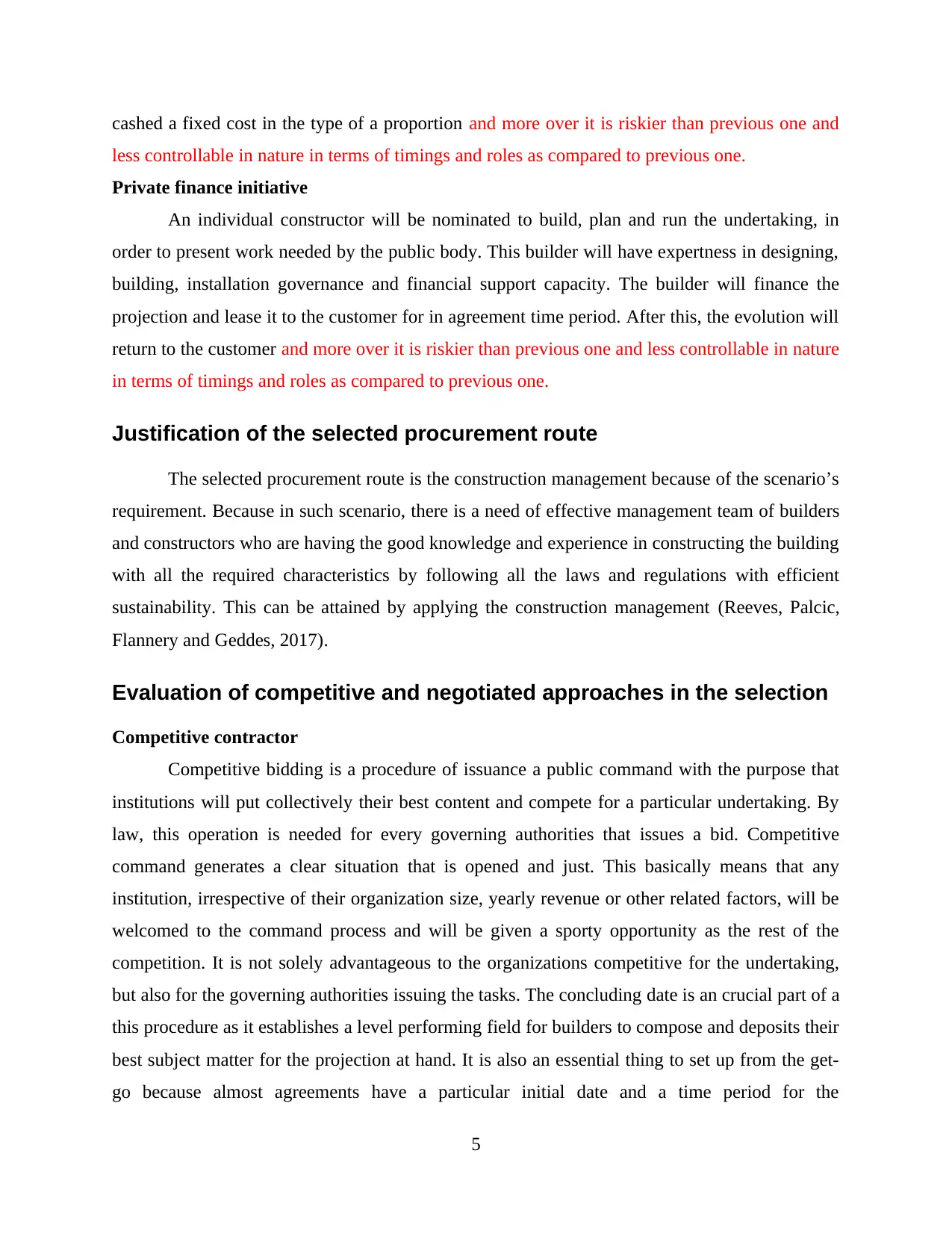
cashed a fixed cost in the type of a proportion and more over it is riskier than previous one and
less controllable in nature in terms of timings and roles as compared to previous one.
Private finance initiative
An individual constructor will be nominated to build, plan and run the undertaking, in
order to present work needed by the public body. This builder will have expertness in designing,
building, installation governance and financial support capacity. The builder will finance the
projection and lease it to the customer for in agreement time period. After this, the evolution will
return to the customer and more over it is riskier than previous one and less controllable in nature
in terms of timings and roles as compared to previous one.
Justification of the selected procurement route
The selected procurement route is the construction management because of the scenario’s
requirement. Because in such scenario, there is a need of effective management team of builders
and constructors who are having the good knowledge and experience in constructing the building
with all the required characteristics by following all the laws and regulations with efficient
sustainability. This can be attained by applying the construction management (Reeves, Palcic,
Flannery and Geddes, 2017).
Evaluation of competitive and negotiated approaches in the selection
Competitive contractor
Competitive bidding is a procedure of issuance a public command with the purpose that
institutions will put collectively their best content and compete for a particular undertaking. By
law, this operation is needed for every governing authorities that issues a bid. Competitive
command generates a clear situation that is opened and just. This basically means that any
institution, irrespective of their organization size, yearly revenue or other related factors, will be
welcomed to the command process and will be given a sporty opportunity as the rest of the
competition. It is not solely advantageous to the organizations competitive for the undertaking,
but also for the governing authorities issuing the tasks. The concluding date is an crucial part of a
this procedure as it establishes a level performing field for builders to compose and deposits their
best subject matter for the projection at hand. It is also an essential thing to set up from the get-
go because almost agreements have a particular initial date and a time period for the
5
less controllable in nature in terms of timings and roles as compared to previous one.
Private finance initiative
An individual constructor will be nominated to build, plan and run the undertaking, in
order to present work needed by the public body. This builder will have expertness in designing,
building, installation governance and financial support capacity. The builder will finance the
projection and lease it to the customer for in agreement time period. After this, the evolution will
return to the customer and more over it is riskier than previous one and less controllable in nature
in terms of timings and roles as compared to previous one.
Justification of the selected procurement route
The selected procurement route is the construction management because of the scenario’s
requirement. Because in such scenario, there is a need of effective management team of builders
and constructors who are having the good knowledge and experience in constructing the building
with all the required characteristics by following all the laws and regulations with efficient
sustainability. This can be attained by applying the construction management (Reeves, Palcic,
Flannery and Geddes, 2017).
Evaluation of competitive and negotiated approaches in the selection
Competitive contractor
Competitive bidding is a procedure of issuance a public command with the purpose that
institutions will put collectively their best content and compete for a particular undertaking. By
law, this operation is needed for every governing authorities that issues a bid. Competitive
command generates a clear situation that is opened and just. This basically means that any
institution, irrespective of their organization size, yearly revenue or other related factors, will be
welcomed to the command process and will be given a sporty opportunity as the rest of the
competition. It is not solely advantageous to the organizations competitive for the undertaking,
but also for the governing authorities issuing the tasks. The concluding date is an crucial part of a
this procedure as it establishes a level performing field for builders to compose and deposits their
best subject matter for the projection at hand. It is also an essential thing to set up from the get-
go because almost agreements have a particular initial date and a time period for the
5
Paraphrase This Document
Need a fresh take? Get an instant paraphrase of this document with our AI Paraphraser
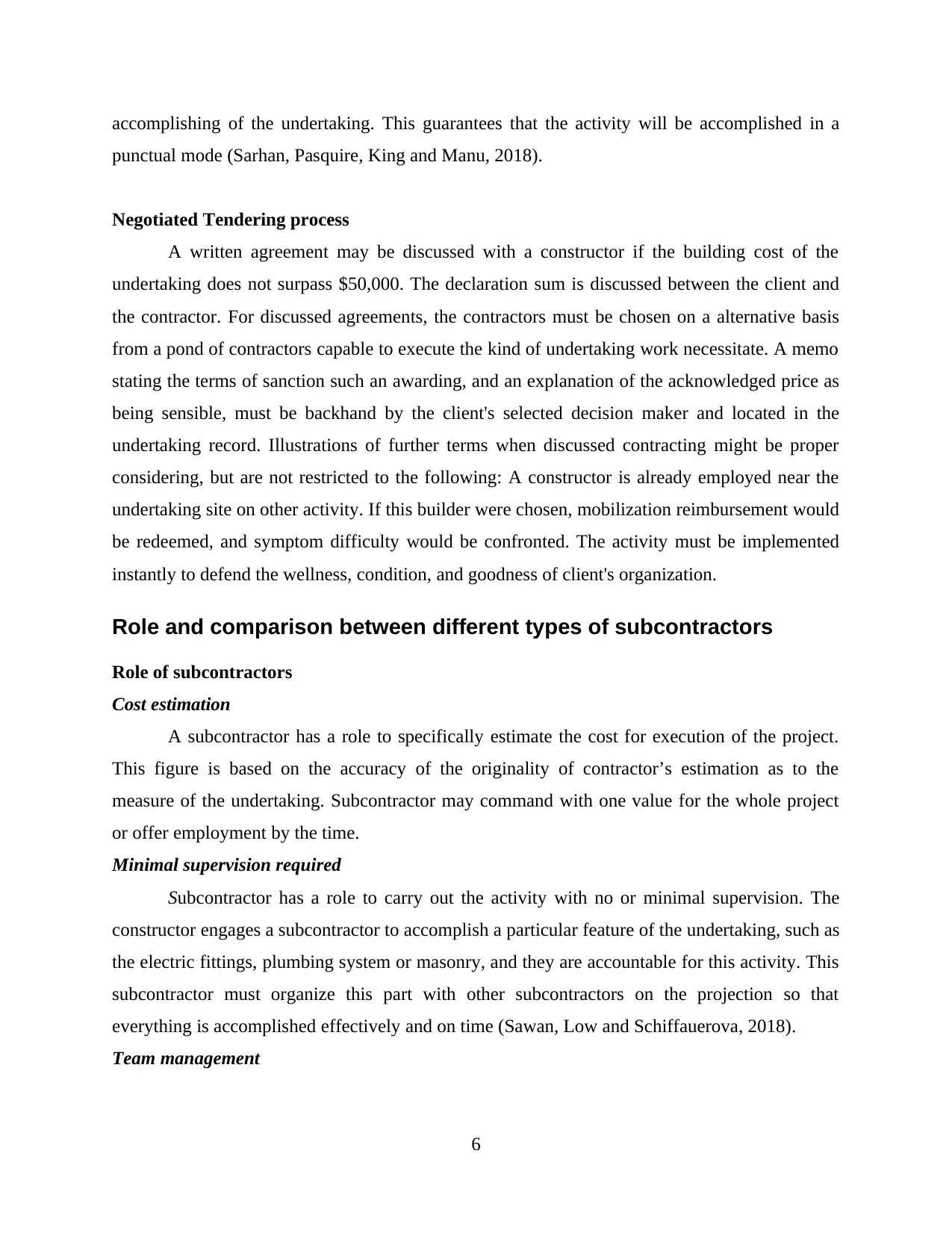
accomplishing of the undertaking. This guarantees that the activity will be accomplished in a
punctual mode (Sarhan, Pasquire, King and Manu, 2018).
Negotiated Tendering process
A written agreement may be discussed with a constructor if the building cost of the
undertaking does not surpass $50,000. The declaration sum is discussed between the client and
the contractor. For discussed agreements, the contractors must be chosen on a alternative basis
from a pond of contractors capable to execute the kind of undertaking work necessitate. A memo
stating the terms of sanction such an awarding, and an explanation of the acknowledged price as
being sensible, must be backhand by the client's selected decision maker and located in the
undertaking record. Illustrations of further terms when discussed contracting might be proper
considering, but are not restricted to the following: A constructor is already employed near the
undertaking site on other activity. If this builder were chosen, mobilization reimbursement would
be redeemed, and symptom difficulty would be confronted. The activity must be implemented
instantly to defend the wellness, condition, and goodness of client's organization.
Role and comparison between different types of subcontractors
Role of subcontractors
Cost estimation
A subcontractor has a role to specifically estimate the cost for execution of the project.
This figure is based on the accuracy of the originality of contractor’s estimation as to the
measure of the undertaking. Subcontractor may command with one value for the whole project
or offer employment by the time.
Minimal supervision required
Subcontractor has a role to carry out the activity with no or minimal supervision. The
constructor engages a subcontractor to accomplish a particular feature of the undertaking, such as
the electric fittings, plumbing system or masonry, and they are accountable for this activity. This
subcontractor must organize this part with other subcontractors on the projection so that
everything is accomplished effectively and on time (Sawan, Low and Schiffauerova, 2018).
Team management
6
punctual mode (Sarhan, Pasquire, King and Manu, 2018).
Negotiated Tendering process
A written agreement may be discussed with a constructor if the building cost of the
undertaking does not surpass $50,000. The declaration sum is discussed between the client and
the contractor. For discussed agreements, the contractors must be chosen on a alternative basis
from a pond of contractors capable to execute the kind of undertaking work necessitate. A memo
stating the terms of sanction such an awarding, and an explanation of the acknowledged price as
being sensible, must be backhand by the client's selected decision maker and located in the
undertaking record. Illustrations of further terms when discussed contracting might be proper
considering, but are not restricted to the following: A constructor is already employed near the
undertaking site on other activity. If this builder were chosen, mobilization reimbursement would
be redeemed, and symptom difficulty would be confronted. The activity must be implemented
instantly to defend the wellness, condition, and goodness of client's organization.
Role and comparison between different types of subcontractors
Role of subcontractors
Cost estimation
A subcontractor has a role to specifically estimate the cost for execution of the project.
This figure is based on the accuracy of the originality of contractor’s estimation as to the
measure of the undertaking. Subcontractor may command with one value for the whole project
or offer employment by the time.
Minimal supervision required
Subcontractor has a role to carry out the activity with no or minimal supervision. The
constructor engages a subcontractor to accomplish a particular feature of the undertaking, such as
the electric fittings, plumbing system or masonry, and they are accountable for this activity. This
subcontractor must organize this part with other subcontractors on the projection so that
everything is accomplished effectively and on time (Sawan, Low and Schiffauerova, 2018).
Team management
6
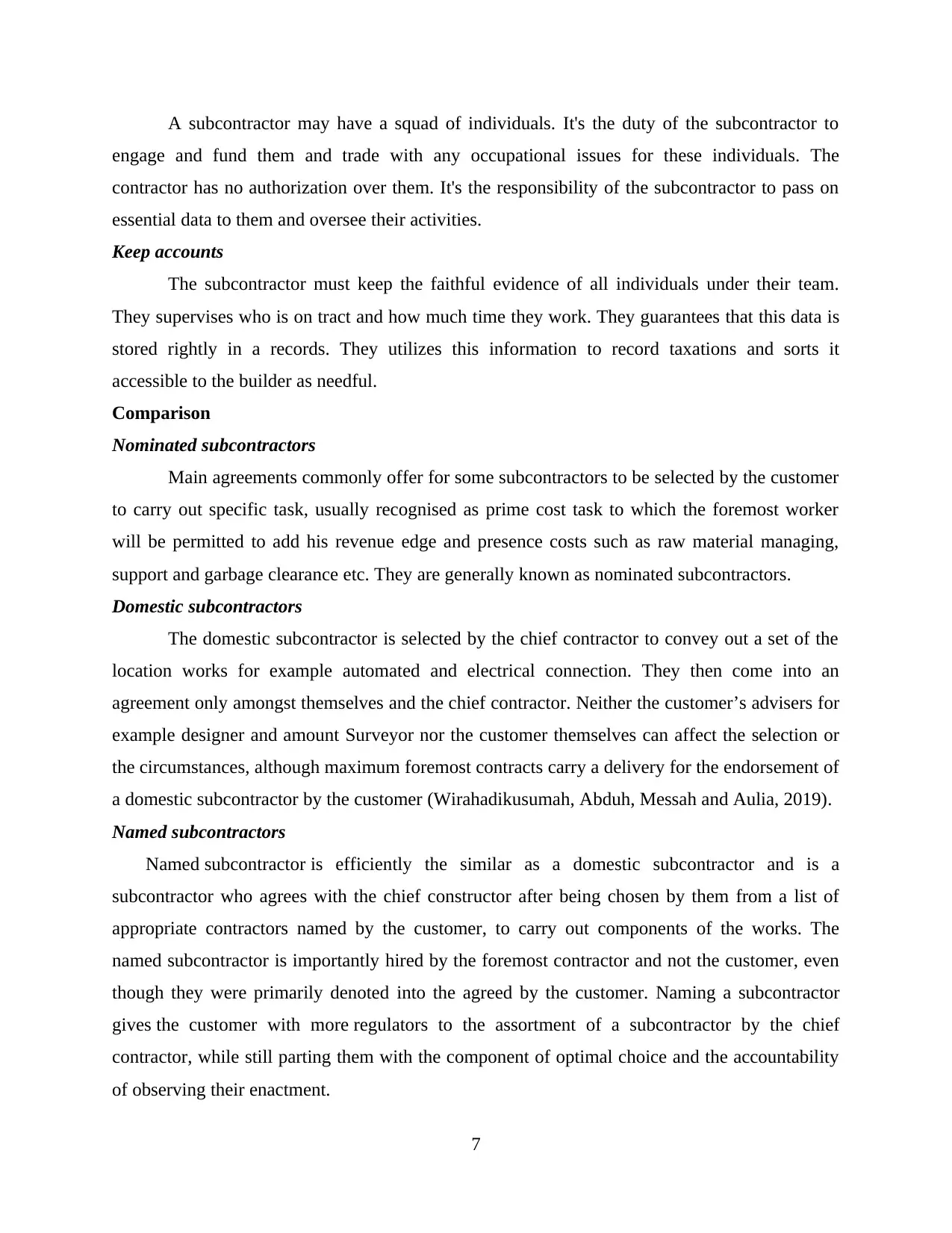
A subcontractor may have a squad of individuals. It's the duty of the subcontractor to
engage and fund them and trade with any occupational issues for these individuals. The
contractor has no authorization over them. It's the responsibility of the subcontractor to pass on
essential data to them and oversee their activities.
Keep accounts
The subcontractor must keep the faithful evidence of all individuals under their team.
They supervises who is on tract and how much time they work. They guarantees that this data is
stored rightly in a records. They utilizes this information to record taxations and sorts it
accessible to the builder as needful.
Comparison
Nominated subcontractors
Main agreements commonly offer for some subcontractors to be selected by the customer
to carry out specific task, usually recognised as prime cost task to which the foremost worker
will be permitted to add his revenue edge and presence costs such as raw material managing,
support and garbage clearance etc. They are generally known as nominated subcontractors.
Domestic subcontractors
The domestic subcontractor is selected by the chief contractor to convey out a set of the
location works for example automated and electrical connection. They then come into an
agreement only amongst themselves and the chief contractor. Neither the customer’s advisers for
example designer and amount Surveyor nor the customer themselves can affect the selection or
the circumstances, although maximum foremost contracts carry a delivery for the endorsement of
a domestic subcontractor by the customer (Wirahadikusumah, Abduh, Messah and Aulia, 2019).
Named subcontractors
Named subcontractor is efficiently the similar as a domestic subcontractor and is a
subcontractor who agrees with the chief constructor after being chosen by them from a list of
appropriate contractors named by the customer, to carry out components of the works. The
named subcontractor is importantly hired by the foremost contractor and not the customer, even
though they were primarily denoted into the agreed by the customer. Naming a subcontractor
gives the customer with more regulators to the assortment of a subcontractor by the chief
contractor, while still parting them with the component of optimal choice and the accountability
of observing their enactment.
7
engage and fund them and trade with any occupational issues for these individuals. The
contractor has no authorization over them. It's the responsibility of the subcontractor to pass on
essential data to them and oversee their activities.
Keep accounts
The subcontractor must keep the faithful evidence of all individuals under their team.
They supervises who is on tract and how much time they work. They guarantees that this data is
stored rightly in a records. They utilizes this information to record taxations and sorts it
accessible to the builder as needful.
Comparison
Nominated subcontractors
Main agreements commonly offer for some subcontractors to be selected by the customer
to carry out specific task, usually recognised as prime cost task to which the foremost worker
will be permitted to add his revenue edge and presence costs such as raw material managing,
support and garbage clearance etc. They are generally known as nominated subcontractors.
Domestic subcontractors
The domestic subcontractor is selected by the chief contractor to convey out a set of the
location works for example automated and electrical connection. They then come into an
agreement only amongst themselves and the chief contractor. Neither the customer’s advisers for
example designer and amount Surveyor nor the customer themselves can affect the selection or
the circumstances, although maximum foremost contracts carry a delivery for the endorsement of
a domestic subcontractor by the customer (Wirahadikusumah, Abduh, Messah and Aulia, 2019).
Named subcontractors
Named subcontractor is efficiently the similar as a domestic subcontractor and is a
subcontractor who agrees with the chief constructor after being chosen by them from a list of
appropriate contractors named by the customer, to carry out components of the works. The
named subcontractor is importantly hired by the foremost contractor and not the customer, even
though they were primarily denoted into the agreed by the customer. Naming a subcontractor
gives the customer with more regulators to the assortment of a subcontractor by the chief
contractor, while still parting them with the component of optimal choice and the accountability
of observing their enactment.
7
⊘ This is a preview!⊘
Do you want full access?
Subscribe today to unlock all pages.

Trusted by 1+ million students worldwide
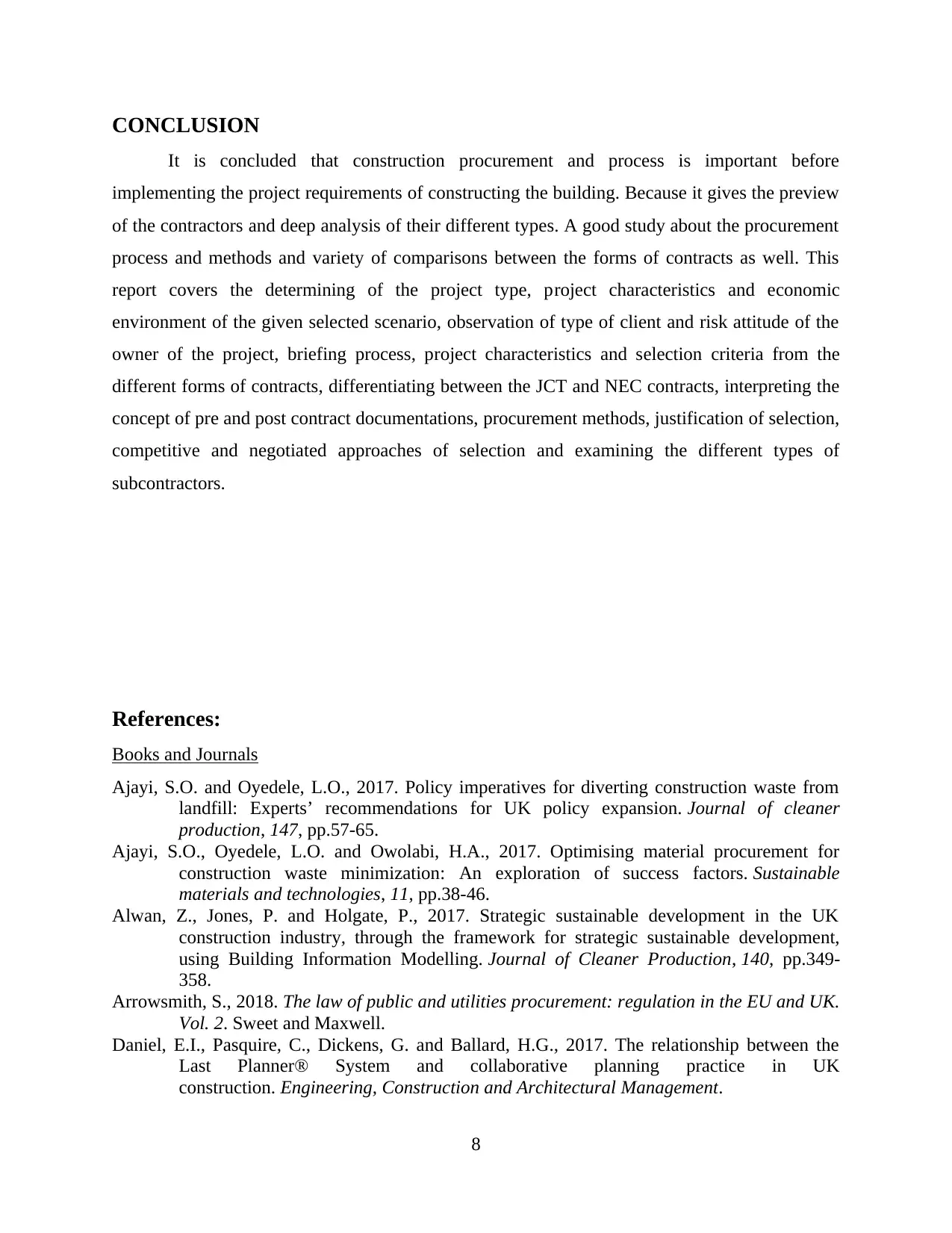
CONCLUSION
It is concluded that construction procurement and process is important before
implementing the project requirements of constructing the building. Because it gives the preview
of the contractors and deep analysis of their different types. A good study about the procurement
process and methods and variety of comparisons between the forms of contracts as well. This
report covers the determining of the project type, project characteristics and economic
environment of the given selected scenario, observation of type of client and risk attitude of the
owner of the project, briefing process, project characteristics and selection criteria from the
different forms of contracts, differentiating between the JCT and NEC contracts, interpreting the
concept of pre and post contract documentations, procurement methods, justification of selection,
competitive and negotiated approaches of selection and examining the different types of
subcontractors.
References:
Books and Journals
Ajayi, S.O. and Oyedele, L.O., 2017. Policy imperatives for diverting construction waste from
landfill: Experts’ recommendations for UK policy expansion. Journal of cleaner
production, 147, pp.57-65.
Ajayi, S.O., Oyedele, L.O. and Owolabi, H.A., 2017. Optimising material procurement for
construction waste minimization: An exploration of success factors. Sustainable
materials and technologies, 11, pp.38-46.
Alwan, Z., Jones, P. and Holgate, P., 2017. Strategic sustainable development in the UK
construction industry, through the framework for strategic sustainable development,
using Building Information Modelling. Journal of Cleaner Production, 140, pp.349-
358.
Arrowsmith, S., 2018. The law of public and utilities procurement: regulation in the EU and UK.
Vol. 2. Sweet and Maxwell.
Daniel, E.I., Pasquire, C., Dickens, G. and Ballard, H.G., 2017. The relationship between the
Last Planner® System and collaborative planning practice in UK
construction. Engineering, Construction and Architectural Management.
8
It is concluded that construction procurement and process is important before
implementing the project requirements of constructing the building. Because it gives the preview
of the contractors and deep analysis of their different types. A good study about the procurement
process and methods and variety of comparisons between the forms of contracts as well. This
report covers the determining of the project type, project characteristics and economic
environment of the given selected scenario, observation of type of client and risk attitude of the
owner of the project, briefing process, project characteristics and selection criteria from the
different forms of contracts, differentiating between the JCT and NEC contracts, interpreting the
concept of pre and post contract documentations, procurement methods, justification of selection,
competitive and negotiated approaches of selection and examining the different types of
subcontractors.
References:
Books and Journals
Ajayi, S.O. and Oyedele, L.O., 2017. Policy imperatives for diverting construction waste from
landfill: Experts’ recommendations for UK policy expansion. Journal of cleaner
production, 147, pp.57-65.
Ajayi, S.O., Oyedele, L.O. and Owolabi, H.A., 2017. Optimising material procurement for
construction waste minimization: An exploration of success factors. Sustainable
materials and technologies, 11, pp.38-46.
Alwan, Z., Jones, P. and Holgate, P., 2017. Strategic sustainable development in the UK
construction industry, through the framework for strategic sustainable development,
using Building Information Modelling. Journal of Cleaner Production, 140, pp.349-
358.
Arrowsmith, S., 2018. The law of public and utilities procurement: regulation in the EU and UK.
Vol. 2. Sweet and Maxwell.
Daniel, E.I., Pasquire, C., Dickens, G. and Ballard, H.G., 2017. The relationship between the
Last Planner® System and collaborative planning practice in UK
construction. Engineering, Construction and Architectural Management.
8
Paraphrase This Document
Need a fresh take? Get an instant paraphrase of this document with our AI Paraphraser
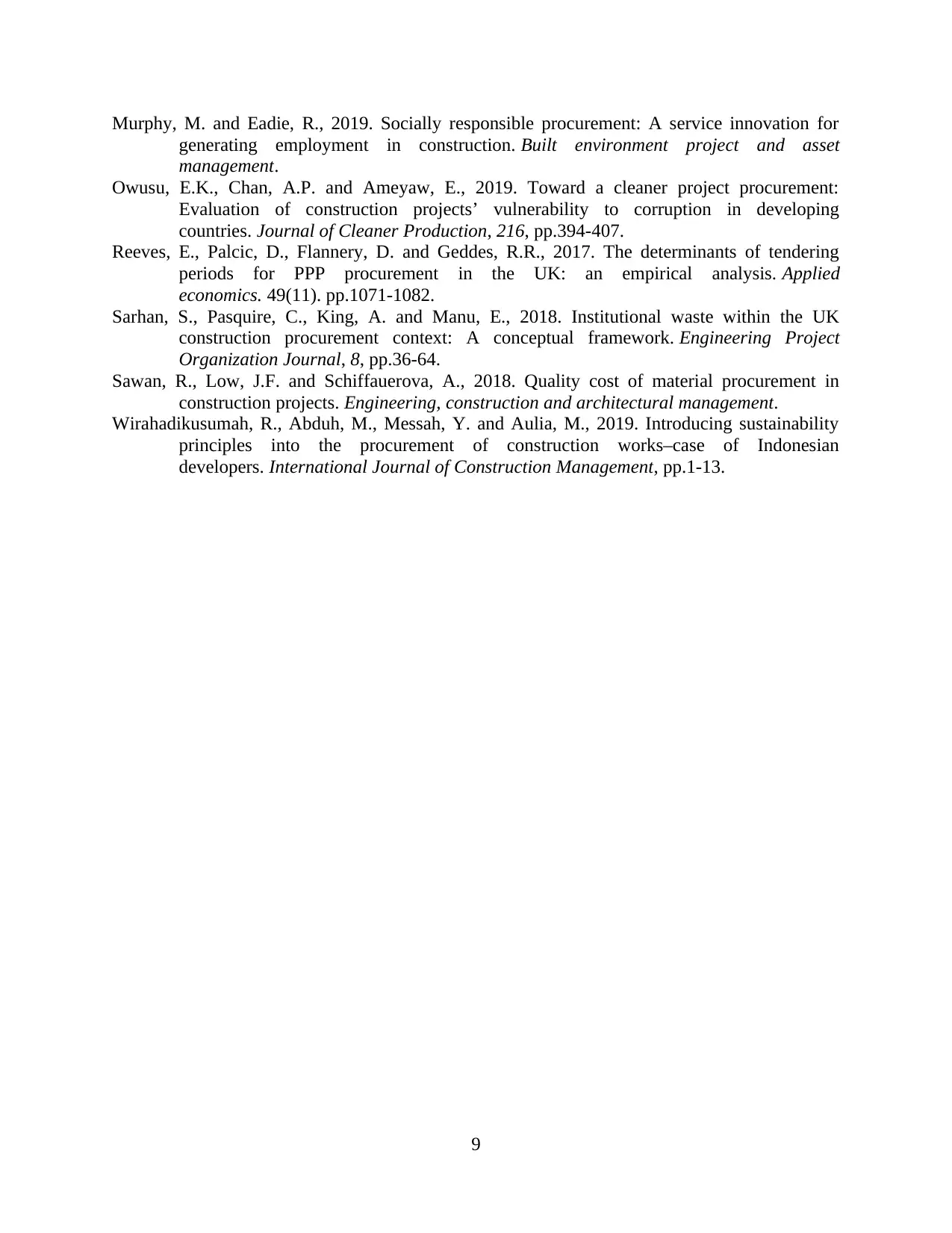
Murphy, M. and Eadie, R., 2019. Socially responsible procurement: A service innovation for
generating employment in construction. Built environment project and asset
management.
Owusu, E.K., Chan, A.P. and Ameyaw, E., 2019. Toward a cleaner project procurement:
Evaluation of construction projects’ vulnerability to corruption in developing
countries. Journal of Cleaner Production, 216, pp.394-407.
Reeves, E., Palcic, D., Flannery, D. and Geddes, R.R., 2017. The determinants of tendering
periods for PPP procurement in the UK: an empirical analysis. Applied
economics. 49(11). pp.1071-1082.
Sarhan, S., Pasquire, C., King, A. and Manu, E., 2018. Institutional waste within the UK
construction procurement context: A conceptual framework. Engineering Project
Organization Journal, 8, pp.36-64.
Sawan, R., Low, J.F. and Schiffauerova, A., 2018. Quality cost of material procurement in
construction projects. Engineering, construction and architectural management.
Wirahadikusumah, R., Abduh, M., Messah, Y. and Aulia, M., 2019. Introducing sustainability
principles into the procurement of construction works–case of Indonesian
developers. International Journal of Construction Management, pp.1-13.
9
generating employment in construction. Built environment project and asset
management.
Owusu, E.K., Chan, A.P. and Ameyaw, E., 2019. Toward a cleaner project procurement:
Evaluation of construction projects’ vulnerability to corruption in developing
countries. Journal of Cleaner Production, 216, pp.394-407.
Reeves, E., Palcic, D., Flannery, D. and Geddes, R.R., 2017. The determinants of tendering
periods for PPP procurement in the UK: an empirical analysis. Applied
economics. 49(11). pp.1071-1082.
Sarhan, S., Pasquire, C., King, A. and Manu, E., 2018. Institutional waste within the UK
construction procurement context: A conceptual framework. Engineering Project
Organization Journal, 8, pp.36-64.
Sawan, R., Low, J.F. and Schiffauerova, A., 2018. Quality cost of material procurement in
construction projects. Engineering, construction and architectural management.
Wirahadikusumah, R., Abduh, M., Messah, Y. and Aulia, M., 2019. Introducing sustainability
principles into the procurement of construction works–case of Indonesian
developers. International Journal of Construction Management, pp.1-13.
9
1 out of 11
Related Documents
Your All-in-One AI-Powered Toolkit for Academic Success.
+13062052269
info@desklib.com
Available 24*7 on WhatsApp / Email
![[object Object]](/_next/static/media/star-bottom.7253800d.svg)
Unlock your academic potential
Copyright © 2020–2025 A2Z Services. All Rights Reserved. Developed and managed by ZUCOL.




